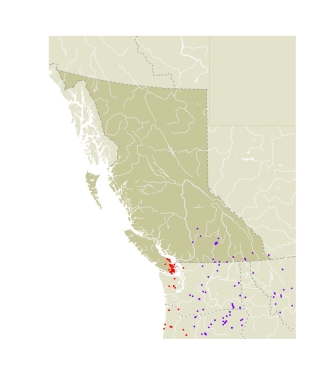Moss' Elfin flies from mid-April to late May. Early emergence depends on a warm, early spring. Eggs are usually laid at the base of the flower of the larval foodplant, Sedum spathulifolium (Hardy 1957). S. lanceolatum is probably used in the interior. Eggs hatch within days and the first instar larvae begin feeding on the flower bud. At the end of the second instar, the larva has consumed or left the flower head. The entire developmental period from egg to pupa takes no more than six weeks. The larvae crawl off the foodplant and pupate on the ground among plant debris. The pupae stay dormant until the following spring, when the next generation of adults emerge.
The number of Vancouver Island populations has been greatly reduced by the development of the Victoria region. In addition, the greatly increased deer population grazes the larval foodplant heavily (CSG). There are still viable populations on some bare rock faces where the larval foodplant, S. spathulifolium, grows abundantly, but this habitat could be seriously damaged by climbers and hikers, such as along the trails on Mt. Finlayson.
|
|
